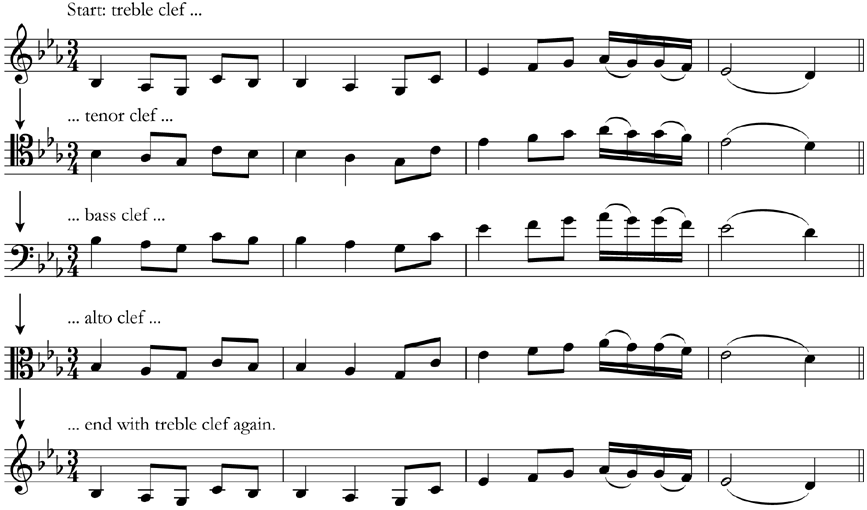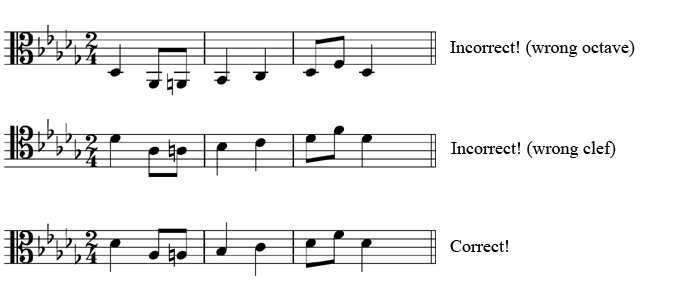The C clefs
In this guide...
Key terms:
Subscription required!
To view the complete study guide, you will need a valid subscription. Why not subscribe now?
Already have a subscription? Make sure you login first!
Introduction
By now you should be familiar with the treble and bass clefs, but there are two more clefs to learn, collectively called the C clefs.
Treble and bass clefs
The two clefs we have dealt with so far are the treble and bass clefs.
Why do we have more than one clef? The reason is for practicality: if we only had, say, the treble clef, then any note lower than D would require ledger lines (for example, middle C on one ledger line). Ledger lines are quite readable so long as we don't use more than two or three. Imagine if you had to read a passage with 5 or 6 ledger lines for every note! Using a bass clef allows us to have another range of notes - from bottom F up to the B below middle C - with no ledger lines.
The following example makes this clear - exactly the same music written in the treble and bass clefs:
 Practicality issues solved by using a different clef
Practicality issues solved by using a different clefThe alto clef
You will have seen the alto clef if you play the viola, but it is unlikely you will have come across it if you play any other instrument.
The purpose of this clef is - like the G and F clefs - to ensure that most of the notes played by the instrument lie on the stave, and the use of ledger lines is minimised.
Just as the treble clef indicates the line for the note G, and the bass clef indicates the line for the note F, the alto clef is designed around the line for the note C. Here it is:
 The alto clef, showing the line for C
The alto clef, showing the line for CThe design of the alto clef is quite simple - it looks a little like the letter "K"; originally it was simply a letter "C" written over the "C" line, and gradually become more ornate to become the alto clef commonly seen today.
As the centre line of the stave is the note C, this means that the top line is a fifth above - G and the bottom line is a fifth below, F.
Finding notes in the alto clef
As shown above, the alto clef is drawn to be centred on the line indicating the note C. This is middle C, and therefore corresponds exactly to the note on the first ledger line below a treble clef stave, and the note on the first ledger line above a bass clef stave.
Here is a short phrase in both the treble and alto clefs:
 The same tune in treble and alto clefs
The same tune in treble and alto clefsNotice how the tune is quite low in the treble stave, requiring ledger lines below the stave, yet sits perfectly in the alto stave. Try writing the tune in the bass clef, and you'll see that it requires ledger lines above the stave. This shows why the alto clef is very useful for instruments (such as the viola) that play music in this "alto" range.
The tenor clef
The tenor clef looks exactly the same as the alto clef, except that it is centred on a different line: the second line down. The design is otherwise the same as an alto clef, and in general these clefs are called C clefs, because they indicate the location of the note C.
Here is the tenor clef, indicating the line for C:
 The tenor clef, showing the line for C
The tenor clef, showing the line for CAs with the alto clef, once you know where to find middle C, it's easy to name the other notes - but always check the key signature!
Finding notes in the tenor clef
The note C around which the tenor clef is drawn is middle C, and therefore corresponds exactly to the note on the first ledger line below a treble clef stave, and the note on the first ledger line above a bass clef stave, and is also the same as the middle line in the alto clef.
Here is a short phrase in both the bass and tenor clefs:
 The same tune in tenor and bass clefs
The same tune in tenor and bass clefsAgain, look at how the tune requires ledger lines when written in the bass clef (as it also would in the treble clef). The tenor clef is much more suitable for music written in this range, and for instruments (such as the cello or trombone) that play in this range.
Learning to read C clefs
Learning to read the C clefs can initially be quite confusing. Here are a few tips:
- The most important thing to remember is where middle C is, and fortunately the design of the clef itself makes this easy.
- Try to get used to counting the notes up or down from middle C in the alto clef.
- It's helpful to memorise some simple "landmarks", for example the top line in alto clef is G and the bottom line is F; in tenor clef the top line is E and the bottom line is D.
- Another help tip is to always look where the octave above or below a given note is. Often if you transpose an unfamiliar note up or down by an octave it can then become more recognisable.
Clefs and key signatures
The position of flats and sharps in key signatures is slightly different in each of the four clefs. The correct positions are shown below, but you should read Keys level 4 and Keys level 5 for more detailed information about key signatures in the C clefs.
 Location of sharps and flats in the key signature in different clefs
Location of sharps and flats in the key signature in different clefsHow to practice
For practice, it is worth copying out music from one clef into another, until you get familiar with all the clefs. Try this exercise, which will help you become familiar with the different clefs quite quickly:
- Find a short piece of music in a clef you are familiar with, and copy it out into the top line of a piece of manuscript paper.
- Roll a dice. Assuming that you started in treble clef, if you roll a 1 or 2, copy the music into alto clef; roll a 3 or 4 and copy it into tenor clef, and roll a 5 or 6 and copy it into bass clef. Copy the music into the second line of the manuscript paper.
- Fold over or cover the first line of the manuscript paper, so you can't see it.
- Roll the dice again. There are two clefs you haven't yet used; let's say you used treble clef in step 1, then tenor clef in step 2, leaving alto and bass clefs unused. If you roll 1, 2 or 3, copy the music from tenor clef (i.e., the music on the second line of the manuscript paper) into alto clef; if you roll 4, 5, or 6, copy it into bass clef. Use the third line of the manuscript paper.
- Fold over or cover the second line of the manuscript paper.
- Copy the third line (from step 4) into the remaining unused clef, using the fourth line of the manuscript paper.
- Now fold over the paper again, leaving just the fourth line showing - and copy the music into the original (first) clef, from step 1. Use the fifth line of the manuscript paper.
- Now unfold the paper and compare the music you have on the fifth line with the music on the first line. They should be the same! If not, try and see where you went wrong, and try the exercise again.
The following example shows how this process should work out:
 A clef transposition exercise
A clef transposition exerciseHere are some PDF files with some melodies in a variety of clefs, together with blank staves, ready for you to print off and practice this exercise.
- Clef exercise 1
- Clef exercise 2
- Clef exercise 3
- Clef exercise 4
- Clef exercise 5
- Clef exercise 6
- Clef exercise 7
- Clef exercise 8
- Clef exercise 9
- Clef exercise 10
Transposing between clefs
You will quite need to transpose by an octave from one clef to another. In these cases, it is vital that you know where middle C is in each clef, so that you can transpose to the correct octave.
Apart from the octave transposition, this is just the same as the exercise described above.
Here are two example questions.
Question #1
1. Transpose down one octave, using the tenor clef:
 Transpose down one octave, using the tenor clef
Transpose down one octave, using the tenor clef Top: Incorrect! (wrong octave), Bottom: Correct!
Top: Incorrect! (wrong octave), Bottom: Correct!Question #2
2. Transpose up one octave, using the alto clef:
 Transpose up one octave, using the alto clef
Transpose up one octave, using the alto clef Top: Incorrect! (wrong octave), Middle: Incorrect! (wrong clef), Bottom: Correct!
Top: Incorrect! (wrong octave), Middle: Incorrect! (wrong clef), Bottom: Correct!Read more...
With a subscription to Clements Theory you'll be able to read this and dozens of other study guides, along with thousands of practice questions and more! Why not subscribe now?
Revision
Are you sure you've understood everything in this study guide? Why not try the following practice questions, just to be sure!